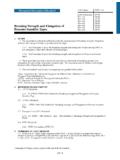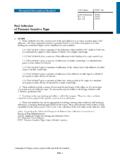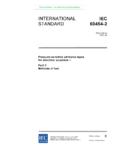Transcription of Shear Adhesion of Pressure Sensitive Tape - …
1 107-11. These procedures help determine the ability of a Pressure Sensitive tape to remain adhered under a constant load applied parallel to the surface of the tape and substrate. Shear Adhesion ( Shear resistance) is the ability of a tape to resist static forces applied in the same plane as the Procedure A measures the Shear Adhesion when applied to a vertical standard steel Procedure B measures the Shear Adhesion when applied to a vertical panel covered with NIST (National Institute of Standards and Technology, USA) SRM 1810A standard Procedure C measures the Shear Adhesion when applied to vertical panel covered with a fiberboard agreed upon by the buyer and Procedure D measures the Shear Adhesion of reinforced filament tape when applied to a horizontal standard steel Procedure E measures the Shear Adhesion of a filament-reinforced tape when applied to a horizontal panel covered with NIST SRM 1810A standard Procedure F measures Shear Adhesion of a filament-reinforced tape when applied to a horizontal panel covered with a fiberboard agreed upon by the buyer and seller.
2 Procedure G is the same as Test Method A except the test is conducted at an elevated temperature and a 10-minute dwell time. These procedures provide a means of assessing the uniformity of the adhesive of a given type of Pressure Sensitive tape (an example are tapes used for packaging applications). The assessment may be within a roll of tape , between rolls or production lots. Variations in the tape backing and adhesive affect the results, therefore, these methods cannot be used to pinpoint the specific cause(s) of : Association des Fabricants Europeens de Rubans Auto-Adhesives (Association of European tape Manufacturers)ASTM: American Society for Testing and Materials (USA)EN: European Norm (Europe)PSTC: Pressure Sensitive tape Council (North America) Shear Adhesion of Pressure Sensitive TapeCall Letters PSTC 107 Date of Issuance 10/00 Revised 10/03 Revised 05/07 Harmonized International StandardA Summary of Changes section appears at the end of this test REFERENCED ASTM Standards.
3 D 3654/D 3654M Standard Test Method for Holding Power of Pressure - Sensitive Tapes D 3715 Practice for Quality Assurance of Pressure - Sensitive Tapes D 5750 Guide for Width and Lengths of Pressure - Sensitive AFERA AFERA 5012 Self Adhesive Tapes - Measurement of Static Shear CEN EN 1943 Self Adhesive Tapes - Measurement of Static Shear EN 10088/2, 2R - Specification for Stainless Steel PSTC PSTC-107 Shear Adhesion of Pressure Sensitive tape 3. SUMMARY OF TEST Procedure A - Shear Adhesion to standard steel panel - A strip of tape is applied to a standard steel panel under controlled roll down. The panel is mounted vertically, a standard mass is attached to the free end of the tape and the time to failure is determined. Procedure B - Shear Adhesion to a standard NIST fiberboard - A strip of tape is applied to a panel covered with NIST SRM 1810A fiberboard under controlled Pressure .
4 The panel is mounted vertically, a standard mass is attached to the free end of the tape and the time to failure is Procedure C - Shear Adhesion to a vertical fiberboard surface with controlled roll down (see Figure 1). The fiberboard, corrugated board, or other substrate agreed upon prior to testing and described in the report section. A standard mass is attached to the tape and the time to failure is determined (see Figure 2). Procedure D - Shear Adhesion to a standard steel panel. A strip of filament-reinforced tape is applied to a standard steel panel with a 120 bend at one end with controlled roll down. The panel is mounted horizontally, tape side up, with the free end of the tape allowed to hang vertically over the rounded end. A standard mass is attached to the end of the tape and allowed to act for specified Procedure E - Shear Adhesion of filament reinforced tape to a standard (NIST) fiberboard - A strip of reinforced filament tape is applied to a panel with a 120 bend, covered with NIST SRM 1810A standard fiberboard under controlled roll down.
5 The panel is mounted horizontally, tape side up, with the free end of the tape allowed to hang vertically over the rounded end of the panel. A standard mass is attached to the end of the tape and allowed to act for specified time (see Figure 3). Procedure F - Shear Adhesion of filament reinforced tape to a fiberboard - A strip of reinforced filament tape is applied to a panel with a 120 bend at one end under controlled roll down. The panel is covered with a fiberboard, corrugated board or other substrate agreed upon prior to testing and described in Section 12. The panel is mounted horizontally, tape side up, with the free end of the tape allowed to hang vertically over the round end of the panel. A standard mass is attached to the end of the tape and allowed to act for a specified Procedure G - This test method is conducted as described in Procedure A except the test is conducted at an elevated temperature.
6 For Procedures A, B, C, and G the normal test area shall be 12 by 12 mm. A test area of 24 by 24 mm may be specified. For Procedures D, E, F, the specimen width shall be 12 SIGNIFICANCE AND Procedure A measures the ability of a Pressure Sensitive tape to adhere to a standard steel panel under constant stress. This may or may not relate to the ability of the tape to adhere to other Procedure B may be used to determine the Shear Adhesion of tapes generally used to close fiberboard boxes in packaging Procedure C measures the ability of a Pressure Sensitive tape to adhere to a non-standard fiber-board, linerboard or other substrate which is agreed upon for testing. This may be used to compare the Shear Adhesion of tapes to a particular surface or to compare the Shear Adhesion of a tape to a variety of The surface of similar fiberboard may exhibit considerable variations between paper mills, between batches from one mill, and within batches.
7 Take care in the choice of samples and when comparing test results between substrates which may not be exactly the The precision of test conducted on non-standard surfaces may be different from that described in section Procedures D, E, and F may be used to determine the ability of a filament reinforced tape to hold when placed under constant stress. The reinforced tapes may also be tested using Procedures A, B, and C. Procedure G may be used to compare the Shear Adhesion of tape when applied to a standard steel surface and tested at an elevated temperature (see and ). 5. Specimen cutter - The specimen cutter shall hold two single edge razor blades in parallel planes, a precise distance apart, to form a cutter of exact specimens widths. Two cutters, 12 and 24 mm cutting width, shall be available or appropriate alternates which will not cause edge 1 - The 12 mm cutter shall consist of a bar stock 1 mm wide.
8 The edges for about 125 mm from one end shall be slightly rounded to form a handle. The width of the end of the bar shall be narrowed to exactly 12 mm minus the thickness of a single edge razor (one of two used as cutting edges). The razor blades shall be held in position using side plates. The end of the cutter shall be cut away at a 45 angle to expose the cutting edge at one end of the blades. The edges shall be separated by 12 mm. The 24 mm cutter shall follow the same description except the bar stock shall be mm wide and shall be narrowed to exactly 24 mm minus the thickness of a single edge razor. Note 2 - These widths correspond to the primary metric (SI) units described in ASTM D 5750. If it is desirable to test slightly different widths ( or 25 mm) of specimens per , this should be noted per Note 3 - There may be several suppliers of these items. See Appendix Dispensing system, for solvents, such as a wash For Procedures A, B, C, and H, a panel at least 50 mm long and 50 mm wide and not less than mm thickness stainless steel 302 or 304 in accordance with Specification EN 10088/2, 2R having a bright annealed finish.
9 The surface roughness height shall be 50 25 nm arithmetical average deviation from the mean line. One or both panel ends shall be ground to form a 90 angle with the surface. Panels showing stains, discoloration, or many scratches are not acceptable. New panels should be cleaned prior to use as , except with ten washes of the final solvent. Between uses, the panel test surface shall be protected from scratches and contamination, and the panels stored at conditions described in For Procedures D, E, and F, a panel as described in shall have a 12 mm length of one end of the panel bent through an arc of 120 away from the test surface. The radius of the curvature of the finished surface at the bend shall be to 3 Roller, mechanically or hand A steel roller 85 mm, in diameter and 45 mm in width, covered with rubber approximately 6 mm in thickness, having a Shore scale A durometer hardness of 80 5.
10 The surface shall be a true cylinder void of any convex or concave deviations. The mass of the roller shall be 2 kg No part of the apparatus shall increase the Pressure of the roller during use. The roller shall move either mechanically or by hand at the rate of 10 mm/s. (See Figure 5.) Test stands and ancillary Procedures A, B, C, and G - A test stand that shall hold the test panel (see Figure 6), with the tape applied, at an angle of 2 with the vertical, so that when the mass is acting on the test specimen, no peel forces will be exerted on the tape . Procedures D, E, and F - A test stand that will support the test panel in a horizontal plane, approximately 300 mm above the work surface. Clamp, that will allow the attachment of the mass to the specimen, distributing the load equally across the tape specimen Test Procedures A, B, D, and H. The test mass shall be 1000 5 g or other mass as specified.








